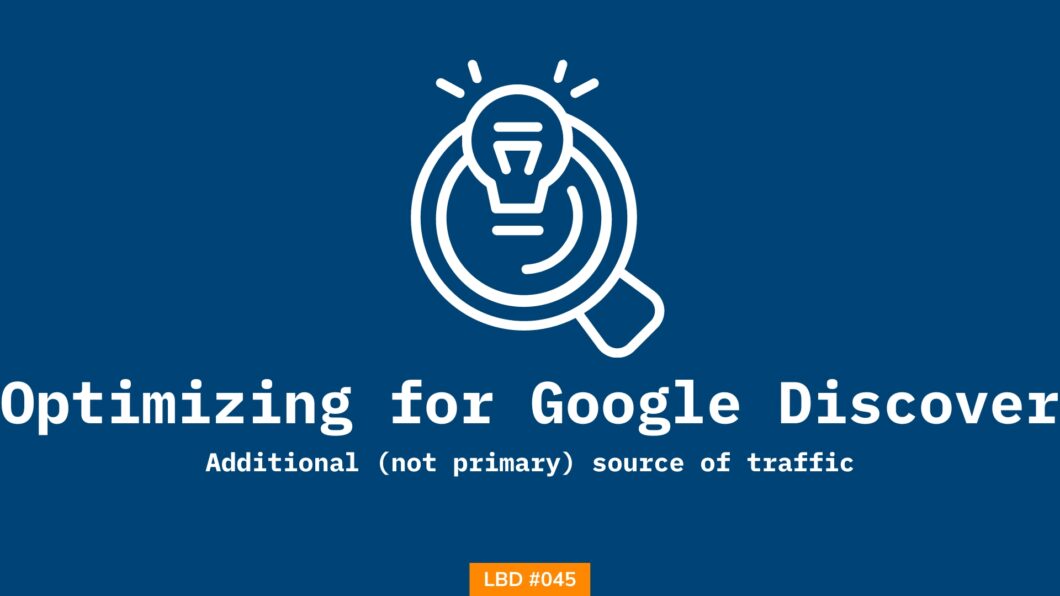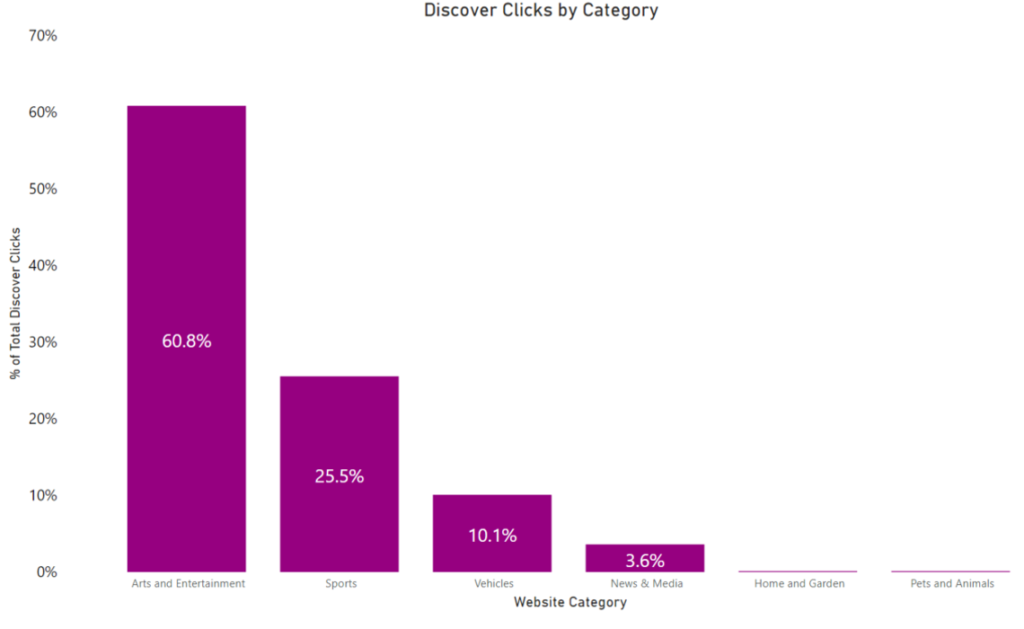Reading time: 273 seconds
Google Discover is the best additional source of traffic (Definitely not the primary one)
What would you do with additional traffic from 3.3 billion Android devices?
Google Discover is an untapped mine for traffic & potential sales.
By the end of this issue, you will be able to:
- Learn how to optimize content for the Google Discover feed
- Pros and cons of Google Discover
- Mistakes to avoid while relying on traffic from Google Discover
Google Discover is a game-changer traffic source for any content-led blog. But the fact that creators/publishers have little to no control over the traffic makes it a big problem.
Miss out on optimizing for Google Discover & lose the chance of additional traffic forever. So instead…
SEO has gotten tougher (at least for beginners) and there are very few avenues left for getting traffic. If you’re aware of how to optimize your pages for Google Discover, you can at least have some source of traffic (although it’s too dangerous to have it as the only source)
Rewards have no ceilings, Google Discover is “turned on” by default for all Android devices, that’s well over 3.3 billion users. Let me remind you, Google pays $5 billion every year to Apple to be the default search engine on the Safari browser. That’s the power of default.
Although there are no settings or applications to list your content on Google Discover, you can optimize your content (& follow Google Discover policies). Sure there are several things & opinions around this, but here are the top 3 things you should do to get your content over the fence on Google Discover:
Table of Contents
Step 1: Focus on demands, habits & trends
Google Discover is a feed that auto-populates content based on search history & interest. Don’t expect the content you optimize for search to get there. Sure you can hope, but the optimizations are a little different.
Focus on the search habits of your target audience (this requires some serious brainstorming), since this is an interest-based feed, you can’t tame that animal. Not a bit. Unlike social media where you create content and the algorithm will find users for your content (that’s literally it), Google Discover doesn’t give any controls.
In fact, Lily Ray conducted a full-length study on over 7000 URLs and found categories that predominantly get a ton of traffic from Google Discover.
Notice anything here? None of these categories are keyword-heavy niches. All these categories are interest-heavy.
Something tells me, optimizing for Pinterest will be good enough for Google Discover as well. Yet another source of quality traffic (You’re welcome 😉)
Speaking of categories brings us to the next step, probably the most important.
Step 2: Write about topics, forget keywords
This applies to SEO as well. The whole point of keyword research tools was to give an idea about what ‘topics’ to target. The same applies to content for Google Discover.
The fact Google Discover is an interest/habit-based feed makes it very difficult to optimize for keywords & expect to get in feeds of Google Discover of your target audience.
Remember, Google Discover is an “interest-based” feed. When someone is interested in “Pet Dogs” all your content around that “topic” has the potential to reach their Discover feed. It won’t be limited to keywords like “Dog food”, or “Dog Training“.
This should give you enough perspective to target topics & not keywords. You can consider creating web stories around broader topics (that are more likely to make it to Google Discover) and link back to content targeting a much more specific topic, (Dog food or Dog training)
Web stories are your best shot in this regard. You might break your page in order to optimize for Discover which is the least controllable source of traffic. Leave the content for search & create web stories instead.
Although, Google’s John Mueller said on record that not all web stories may show up on Discover. You should also be aware of the content types that will never show up on Discover.
Step 3: Trigger emotions in the headline
Users aren’t searching for the content you’re trying to optimize for Google Discover. There’s hardly a second or two to hook the readers who’re least expecting your content. How do you do that?
Trigger emotions. Although Google has dedicated a section to saying otherwise, I personally have seen & clicked on titles containing similar words (as below) in the headlines:
- “shocked the nation”
- “unveils a jaw-dropping secret”
- “receives widespread backlash”
- “users demand answers”
- “amidst a surprising twist”
- “reveals the hidden truth”
- “challenges societal norms”
- “sets a groundbreaking record”
- “unveils a revolutionary approach”
- “captures global attention”
- “uncovers a hidden gem”
- “the unexpected outcome”
- “takes the internet by storm”
- “the key to unlocking success”
These aren’t clickbaity, but just below the edge of being called clickbait. You should try these.
Today’s action step → Identify pieces of content that can be optimized for Google Discover. Create web stories & publish them.
SEO this week
- Bard has got some serious updates. Care to check it out? Find out more here.
- Google created a lot of confusion among the SEO community around noidexing syndicated content. Google clarifies more on this.
- “If you’re not buying links, don’t disavow it” – John Mueller
- Google announced that INP (Interaction to Next Paint) will replace FID (First Input Display) in March 2024. Here’s a helpful thread on INP.
- Should you fire your content writer & get $20/mo ChatGPT subscriptions? Check out this experiment to know the truth.
- What did Cyrus Shepard discover being a Quality Rater? Find out here.
- Spilling ‘secrets’ of Google’s Quality Raters (Everything that’s known, in one place) – Read here
- Sub-directory vs Sub-domain: Settling the hot topic [A thread]
- Hitting £10k/month as eCommerce brand – Full story
- What’s the point of updating content when old will anyhow rank? – Patrick Stox did a crazy experiment
Masters of SEO
- Why work hard to get millions of visitors when you can target high-intent keywords? – Here’s how
- Do you have or work for an eCommerce client? – Learn these 5 five life-changing moves
- Understanding No-Follow links – Do they have any significance at all? Find out here
- Learn how to use social media to generate leads, sales, or subscribers
- Simplified Technical SEO guide for beginners
How can I help you?
I put a lot of effort to come up with a single edition of this newsletter. I want to help you in every possible way. But I can do only so much by myself. I want you to tell me what you need help with. You can get in touch with me on LinkedIn, Twitter & Email to share your thoughts & questions that you want to be addressed. I’d be more than happy to help.
Whenever you’re ready to dominate SERPs, here’s how I can help:
- Sit with you 1-on-1 & create a content marketing strategy for your startup. Hire me for consulting
- Write blogs, social posts, and emails for you. Get in touch here with queries (Please mention you found this email in the newsletter to get noticed quickly)
- Join my tribe on Twitter & LinkedIn where I share SEO tips (every single day) & teaser of the next issue of Letters ByDavey


